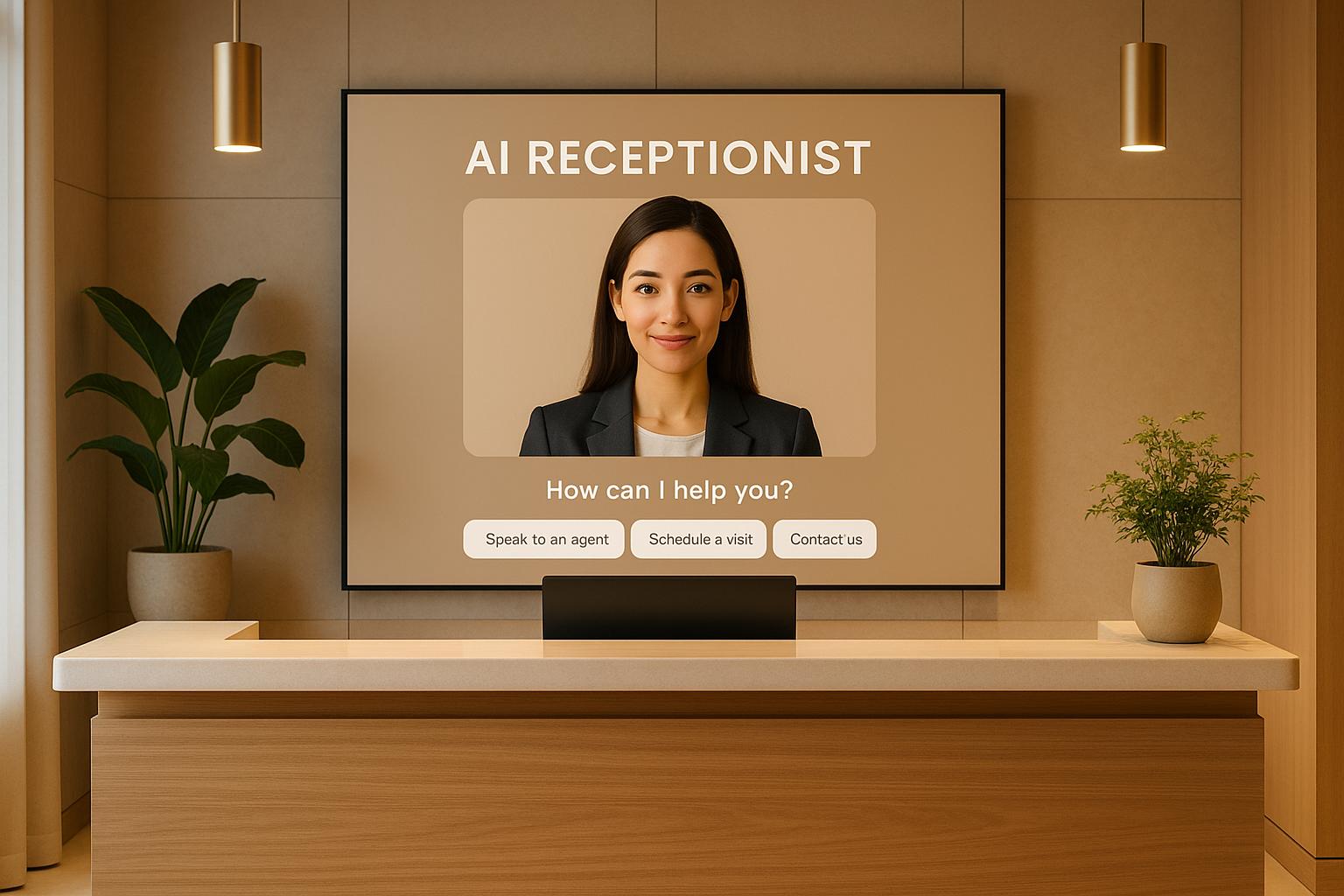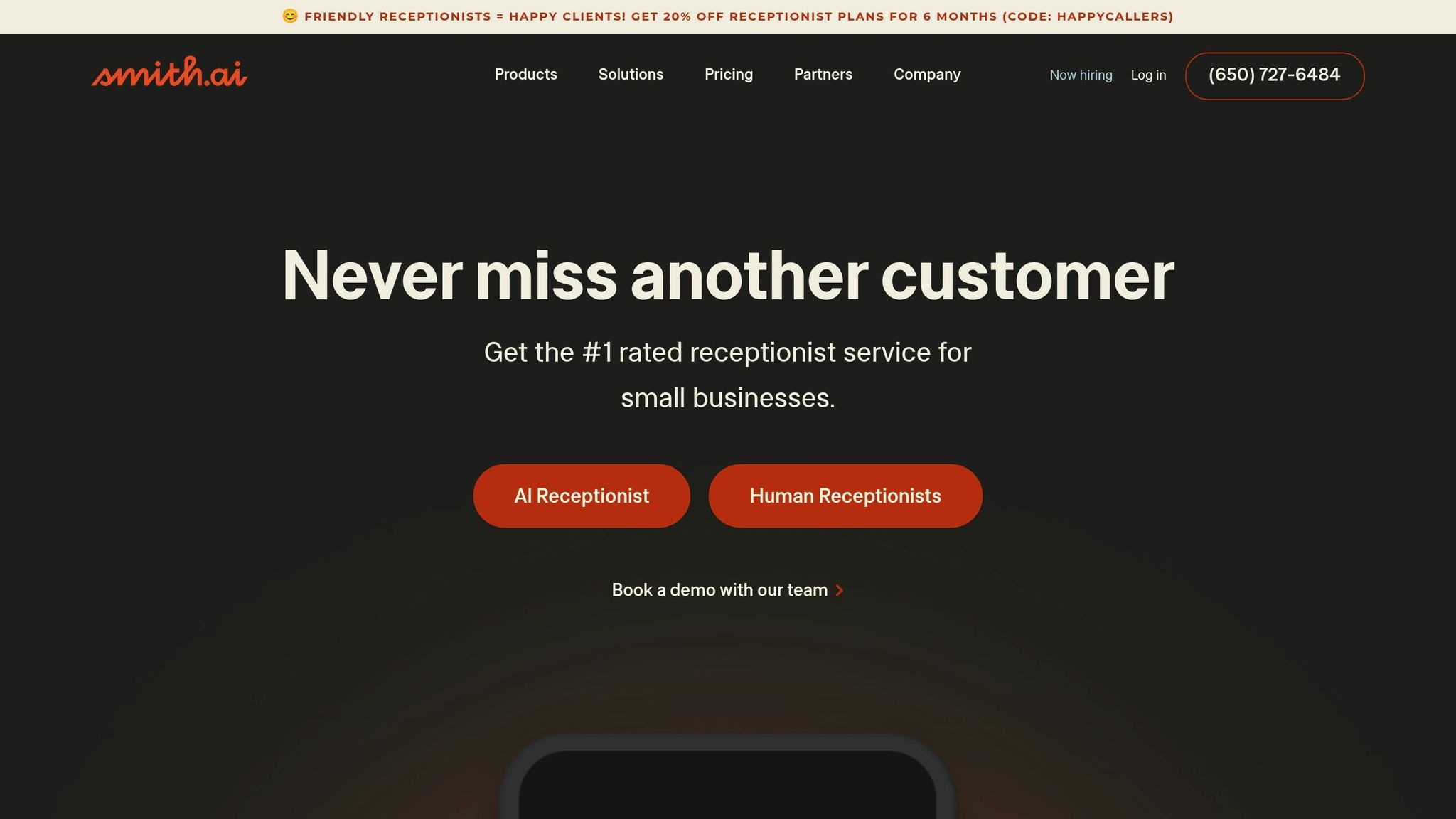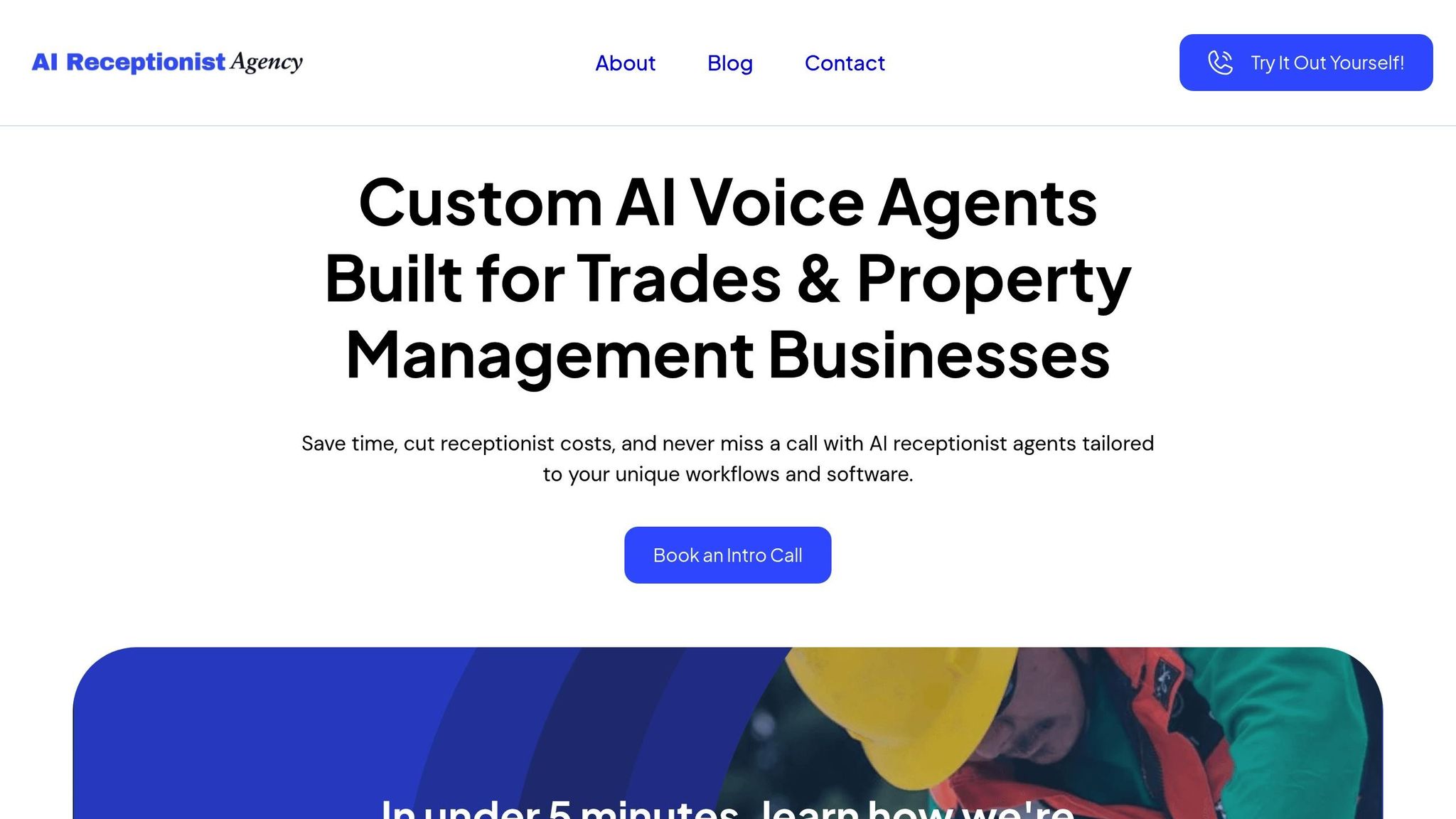
AI receptionists are reshaping how businesses manage customer interactions, offering faster response times, cost savings, and improved lead conversion rates compared to human receptionists. Here’s what you need to know:
Quick Comparison:
| Metric | AI Receptionists | Human Receptionists |
|---|---|---|
| Lead Conversion Rate | 80–90% | 30–60% |
| Annual Cost | $2,100–$12,000 | $57,000–$64,000 |
| Availability | 24/7/365 | Business hours only |
| Call Handling Capacity | 30+ concurrent calls | One call at a time |
| Lead Capture Rate | 85–95% | 20–30% (voicemail) |
AI receptionists offer a modern solution for businesses aiming to improve efficiency, reduce costs, and maximize customer engagement. While human receptionists excel in emotional connection, AI systems provide unmatched consistency and scalability.


The AI Receptionist Agency is transforming how businesses handle lead conversion, delivering up to a 25% revenue increase and 40% higher lead conversion rates compared to traditional methods. Its advanced AI-powered reception services are designed to address common challenges like missed calls and delayed responses, which cause businesses to lose an estimated 85% of potential sales leads.
One standout feature is its round-the-clock availability, which ensures no lead slips through the cracks. This has proven especially valuable for after-hours inquiries. For example, healthcare offices have reported a 40% increase in appointments booked after hours. The platform’s rapid response time - under 30 seconds - further enhances lead generation, boosting conversions by 30%.
The agency’s AI doesn’t just capture leads - it qualifies them. By collecting structured data that human receptionists might overlook, the system ensures prospects are handled based on their specific needs. This approach results in 85-95% of callers providing contact information, compared to just 20-30% with traditional voicemail systems. This robust qualification process sets the stage for tailored solutions across various industries.
The platform offers specialized solutions for industries like healthcare and legal services, including HIPAA-compliant AI systems. These tailored features ensure businesses in sensitive fields can harness AI without compromising on regulatory standards. For instance:
With multi-language capabilities, the system broadens its reach to diverse customer bases. Combined with custom scripts and workflows, businesses can maintain consistent branding while effectively engaging different markets.
The AI Receptionist Agency also delivers significant cost savings, reducing overhead by up to 60% and receptionist costs by up to 85%. Most businesses see a return on their investment within three months, thanks to the improved conversion rates.
Integrating with CRM systems, the platform ensures a streamlined lead management process. Businesses using CRM integration experience a 20% increase in lead conversions. This eliminates manual data entry errors and ensures timely follow-ups, making the entire process more efficient.
The platform’s analytics and reporting tools offer valuable insights for continuous improvement. For instance, one company achieved a 30% sales increase by analyzing AI-generated data and refining their strategies. These insights allow businesses to optimize their efforts based on actual performance metrics.
Unlike human receptionists, who can only manage one call at a time, the AI system can handle unlimited inquiries simultaneously. This ensures no lead is missed, even during peak call volumes, maximizing engagement opportunities and supporting business growth.
Human receptionists bring empathy to their roles, but they often face challenges when it comes to efficiency in converting leads. These challenges can significantly affect a business's overall performance. Let's explore the data and insights surrounding the operational hurdles unique to human receptionists.
According to Invoca's 2025 analysis of 60 million calls, human receptionists achieve an average lead conversion rate of 37%. However, this figure varies widely depending on the industry. Here's a breakdown of conversion rates across sectors:
| Industry | Conversion Rate |
|---|---|
| Home Services | 46% |
| Travel and Hospitality | 43% |
| Automotive | 42% |
| Senior Care | 41% |
| Healthcare | 40% |
| Consumer Services | 36% |
| Telecommunications | 36% |
| Financial Services | 29% |
| Business Services | 22% |
"It's easy to assume that digital commerce has rendered calls to businesses irrelevant. Yet for many companies, especially those with high-value products and services, phone conversations remain critical conversion points where revenue is won or lost." – Peter Isaacson, Chief Marketing Officer at Invoca
Beyond the numbers, human receptionists excel in emotional engagement, a skill that plays a crucial role in customer interactions. Their ability to empathize, read emotions, and respond in real time helps establish trust and build rapport. These traits are especially important in high-stakes or sensitive conversations. While these interpersonal skills are valuable, they must be balanced against the operational challenges that come with relying on human staff.
Employing a receptionist costs businesses around $40,764 annually. When factoring in additional expenses, monthly costs can range from $3,000 to $4,500. Businesses requiring 24/7 coverage face even higher costs, as they must hire extra staff to cover all shifts.
Human receptionists are limited by work hours, breaks, and time off, which often results in missed calls outside of standard business hours. For instance, insurance agencies relying solely on in-house staff miss about 30% of incoming calls after hours. Scaling operations to handle increased call volumes requires hiring and training new staff, a process that is both time-consuming and expensive. Additionally, high turnover rates - averaging 35% to 45% annually in call centers - further complicate staffing efforts.
The performance of human receptionists can fluctuate based on experience, fatigue, and stress levels. New hires often require weeks or even months of training to reach optimal efficiency. This learning curve can negatively impact the quality of customer interactions during the onboarding phase, potentially reducing lead conversion rates.
Certain industries, such as healthcare and legal services, demand specialized training to meet strict compliance standards like HIPAA. While live interactions remain the preferred choice for 75% of customers, the additional training required to meet industry-specific needs can significantly increase costs and complexity for businesses.
The data reveals a clear distinction in lead conversion performance between AI receptionists and their human counterparts across key business metrics. Let’s break down how each performs in critical areas.
AI receptionists consistently deliver stronger results when it comes to converting leads. While human receptionists typically achieve conversion rates between 30% and 60%, depending on staffing levels and other factors, businesses using AI solutions see conversion rates climb by as much as 40%. In the healthcare sector, for example, AI receptionists have been shown to boost conversion rates from 60% to over 85%, thanks to their ability to maintain consistent messaging and optimize scheduling. Additionally, AI systems outperform human staff during busy periods, delivering about 22% higher conversion rates when demand peaks.
Switching to AI receptionists can significantly cut costs. Small businesses that replace human receptionists - who typically cost $57,000 to $64,000 annually - with AI systems, which range from $2,100 to $12,000 per year, can save between 47% and 68%. Moreover, the financial return is impressive: for every $1 invested in AI receptionists, businesses see an ROI of $4.78, combining direct cost savings with increased revenue opportunities.
One example is a 12-attorney firm that replaced its human receptionists, who cost $195,000 annually, with an AI solution priced at $97,125. This switch saved the firm $97,875 and recaptured an additional $108,000 in revenue from missed after-hours calls, resulting in a 212% ROI in the first year. Notably, client satisfaction also improved by 23% due to faster response times and the elimination of hold times during peak hours.
AI receptionists are available around the clock, ensuring businesses never miss a lead. They capture up to 95% of leads, compared to the limited availability of human receptionists, who only work during business hours. Small businesses can lose roughly $18,000 annually due to missed opportunities outside regular hours. Furthermore, AI systems capture contact information from 85% to 95% of callers, whereas traditional voicemail systems only secure details from 20% to 30%. A New York med spa, for instance, reduced missed calls by 40% after implementing an AI receptionist system.
AI receptionists excel at handling increased workloads without compromising performance. They can manage over 30 simultaneous conversations, enabling businesses to handle peak call volumes effortlessly. By contrast, human receptionists only spend about 37% of their time actively handling calls. Scaling operations with human staff requires hiring and training, which is both time-consuming and complicated by high turnover rates.
While AI systems shine in efficiency and accuracy, human receptionists bring a personal touch. AI receptionists maintain consistent performance regardless of call volume or time of day, cutting patient wait times by 60% and reducing scheduling errors by 80%. They also enhance data accuracy to over 95% and reduce verification times from an average of 12 minutes to under 2 minutes per patient. However, human receptionists excel in emotional engagement and complex problem-solving, offering rapport-building skills that AI cannot replicate. Their performance, though, can vary due to factors like fatigue and stress.
Here’s a side-by-side comparison of key metrics:
| Metric | AI Receptionists | Human Receptionists |
|---|---|---|
| Lead Conversion Rate | 80–90% (consistent) | 30–60% |
| Annual Cost | $2,100–$12,000 | $57,000–$64,000 |
| Availability | 24/7/365 | Business hours only |
| Call Handling Capacity | 30+ concurrent calls | One call at a time |
| Lead Capture Rate | 85–95% | 20–30% (voicemail) |
| Data Accuracy | 95%+ | Variable |
AI receptionists clearly outperform in measurable areas like lead conversion, cost savings, and availability. However, human receptionists continue to hold an edge in emotional intelligence and their ability to navigate complex, nuanced interactions.
The data speaks volumes: AI receptionists provide clear advantages across critical business metrics. Their ability to respond instantly not only drives higher lead conversions but also slashes operational costs significantly.
Here’s why this matters. Leads contacted within five minutes are 21 times more likely to convert, and when prospects are reached within 30 seconds - where 78% of customers choose the first responder - businesses gain a decisive edge.
Real-world examples back this up. A mid-sized SaaS company boosted conversions by 30% within three months. A real estate firm saw its lead conversion rate rise from 30% to 50%, while a local gym reported a 40% jump in new memberships.
The financial benefits are just as striking. Metropolitan Medical Associates cut reception costs by 62% annually, improved appointment scheduling accuracy by 34%, and saw patient satisfaction climb from 72% to 91% in six months. Similarly, Rivera Consulting experienced a 22% increase in client satisfaction and a 15% improvement in prospective client conversions, all while saving advisors five hours of work per week.
Given these results, the recommendation is straightforward: businesses - especially in healthcare, real estate, legal services, and consulting - should seriously consider adopting AI receptionists. The combination of 24/7 availability, consistent service, and substantial cost savings delivers a return on investment that traditional staffing models simply can’t match. For tailored, reliable solutions, companies like The AI Receptionist Agency provide AI-powered services designed to ensure no opportunity slips through the cracks.
The evidence is clear. For businesses aiming to increase lead conversion and minimize costs, AI receptionists are a game-changer. With 75% of potential customers lost when calls go unanswered, implementing AI is not just an upgrade - it’s a necessity.
AI receptionists help boost lead conversion rates by delivering reliable and professional communication around the clock, ensuring no potential client slips through the cracks. Unlike their human counterparts, they’re available 24/7, making it possible for businesses to engage with leads even after traditional office hours.
These AI-powered systems also excel at managing tasks like scheduling, qualifying leads, and handling follow-ups through streamlined workflows. Their capacity to manage large volumes of calls while providing immediate responses ensures a smooth and efficient experience for potential clients, which can significantly improve conversion rates.
Switching to AI receptionists can help businesses save up to $68,000 annually for every $100,000 previously spent on traditional receptionist services. On average, companies experience a return on investment (ROI) within 7 to 10 months, though this timeframe can range from 6 to 12 months depending on factors like industry type, call volume, and how the system is implemented.
These savings are driven by lower overhead expenses, round-the-clock availability, and better lead conversion rates. For businesses looking to grow while managing costs, AI receptionists offer a smart and efficient solution.
AI receptionists are built to handle the rigorous compliance standards required in industries such as healthcare and legal services. In healthcare, for instance, they comply with HIPAA regulations by using advanced encryption, secure access systems, and privacy measures to safeguard sensitive patient data. Similarly, in legal services, they adhere to strict confidentiality protocols to ensure client information stays protected.
Through tailored workflows and robust technical safeguards, AI receptionists enable smooth, secure communication while upholding the highest levels of data protection and privacy.
Stay informed with our latest updates every week.
Our Blogs